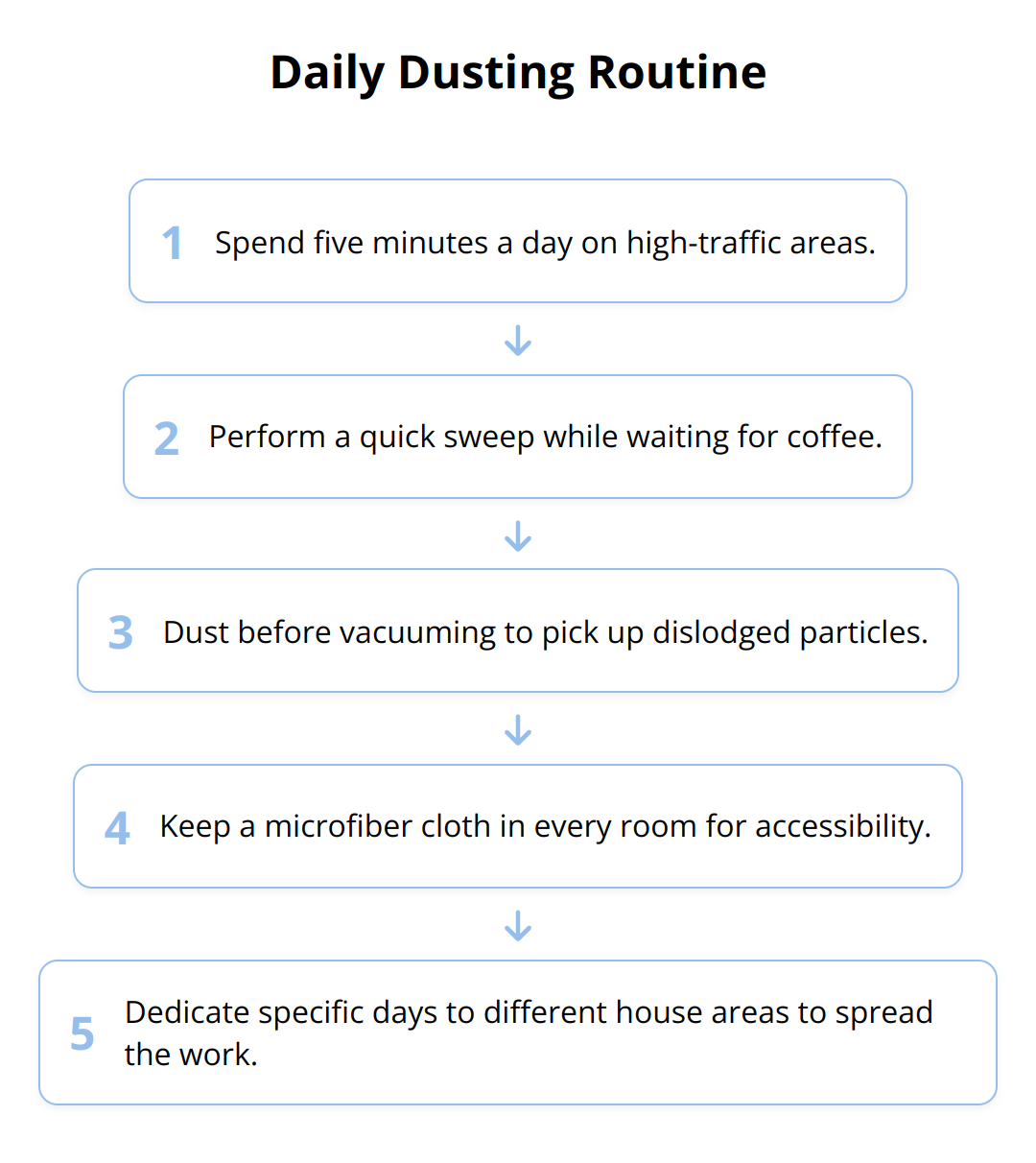We at The A Team Cleaning Services know that your time is precious. Finding efficient ways to keep your home dust-free is key to maintaining a clean and healthy environment.
This post will reveal expert speed dusting strategies, helping you achieve sparkling results in less time. Dive into our toolkit of tips, from essential products to pro techniques for quick and thorough cleaning.
Speed Dusting Tools
Achieving a dust-free home quickly is all about using the right tools. Choosing the right duster is the first step. While traditional feather dusters may look charming, they often just move dust around rather than picking it up. Opt for microfiber dusters instead. Microfiber attracts and holds onto dust particles, preventing them from resettling on surfaces. This material is especially beneficial for allergy sufferers as it can help reduce allergens in the air.
When it comes to products, not all dusting sprays and polishes are created equal. Many people swear by them for adding shine to surfaces, but using them can sometimes slow you down by requiring additional wiping to remove residue. For a speedier approach, use a lightly dampened microfiber cloth; this often negates the need for additional products, cutting down cleaning time. For tougher jobs or to give furniture a quick refresh, choose a non-toxic spray that’s safe for most surfaces. If you’re looking for specific product recommendations, check out our guide on eco-friendly cleaning solutions.
Microfiber cloths vs. traditional dusters, the former clearly wins in speed and efficiency. Not only are microfiber cloths more effective at trapping dust, but they’re also washable and reusable, making them a more economical and environmentally friendly choice. They work excellently on a variety of surfaces without the need for additional chemicals.
For an efficient dusting routine, consider these additional tips:
- Pre-dust with a vacuum: Use a vacuum with a brush attachment to quickly remove dust from large flat areas and upholstery.
- Direction matters: Always dust from top to bottom. This method ensures that any dust that falls will be cleaned up in the next sweep.
- Focus on high-traffic areas: Spend more time dusting places that accumulate dust faster, such as living rooms and bedrooms, where fabric and frequent activity contribute to dust accumulation.
- Routine is key: Regular dusting prevents build-up, making each cleaning session quicker.

By choosing the right tools and employing smart strategies, your dusting routine can be swift and more effective, leaving you more time to enjoy a clean home.
Speed Dusting Techniques
Efficient dusting goes beyond selecting the right tools; it’s also about mastering the technique to maximize every minute spent cleaning. Following the top-to-bottom, left-to-right rule is not just a suggestion—it’s a necessity for speed dusting. This approach guarantees that you won’t have to reclean surfaces and ensures a systematic process that won’t miss any spots.
Dusting should always begin at the highest point in a room, such as the top of cabinets or ceiling fans, and work its way down to the floor. This method captures all the falling dust particles and saves you from having to dust surfaces twice. Similarly, tackling a room from left to right ensures that you don’t skip over areas, making your cleaning efforts more productive.
Addressing hard-to-reach areas can often slow down your dusting routine, but with the right approach, these can be managed swiftly. Extendable dusters are indispensable for reaching high ceilings, behind appliances, and beneath heavy furniture without the need for moving items or climbing ladders. For extremely tight spaces, a simple trick involves attaching a microfiber cloth to the end of a broom or using compressed air to dislodge dust from nooks and crannies.

Preventing dust buildup is not just about what you do while cleaning; it’s also about regular maintenance. Incorporating simple habits like changing HVAC filters regularly, using doormats to trap dirt at entryways, and keeping windows closed on windy days can significantly reduce the amount of dust that enters your home. Similarly, decluttering surfaces makes them easier to dust and reduces the overall time spent cleaning.

When it comes to quick, effective dusting, remember:
- Start high and work your way down
- Move systematically from left to right
- Use extendable tools for hard-to-reach spots
- Prevent dust by maintaining a tidy home environment
For those interested in further optimizing their cleaning routines, dive deeper into efficient space utilization to keep your home organized and easy to clean. By applying these speed dusting strategies, you’re not just cleaning faster; you’re also creating a healthier living space for you and your family.
Dusting Electronics and Delicate Items
Dusting electronics and delicate items requires a gentle touch and attention to detail. Electronics, such as TVs, laptops, and speakers, gather dust quickly, yet they are sensitive to traditional wet cleaning methods. The key to effectively dusting these items is to use a soft, dry microfiber cloth. For screens and delicate surfaces, lightly dampening the cloth with distilled water can remove fingerprints and smudges without risking damage. Always ensure the electronic device is turned off before cleaning.
For delicate items, such as ornaments and picture frames, using a soft brush attachment on a vacuum cleaner can efficiently remove dust without direct contact. This technique reduces the risk of accidental damage. In cases where items are too delicate for any vacuum attachment, a soft paintbrush or makeup brush can dust intricately detailed surfaces effectively.
To maintain the longevity and performance of your electronics, it’s crucial to keep vents unblocked and regularly dust behind and beneath the devices. This not only aids in dust removal but also prevents overheating, which can extend the life of your electronics.
Quick fixes for common dusting challenges can be incredibly straightforward:
- Sticky dust on fans and blinds can be tackled with a mixture of water and vinegar, applied with a microfiber cloth, to break down the grime.
- Pet hair on upholstery often requires more than just dusting. A rubber squeegee can lift hair effectively before you vacuum.
- Stubborn dust in grout and textures surfaces might need a toothbrush dipped in a cleaning solution to get the job done.
Incorporating dusting into your daily cleaning routines doesn’t have to be a chore. Spend five minutes a day targeting high-traffic areas, or perform a quick dusting sweep while waiting for your morning coffee. Daily maintenance is easier than a once-a-week overhaul and keeps your home consistently clean.

- Always dust before vacuuming; this ensures any dislodged dust particles are picked up.
- Keep a microfiber cloth in every room for easy access.
- Dedicate specific days to different areas of your house to spread out the work and avoid overwhelm.
For more detailed guidance on keeping your living space fresh, consider exploring tips on refreshing your home. By integrating these strategies into your routine, dusting electronics, tackling common challenges, and keeping up with daily dusting can seamlessly blend into your lifestyle, ensuring your home stays pristine with minimal effort.
Wrapping Up
In this post, we’ve explored a variety of speed dusting strategies to help you clean more effectively and efficiently. Utilizing the right tools, such as microfiber dusters and cloths, and employing specific techniques, like top-to-bottom and left-to-right cleaning, can drastically reduce the time you spend dusting your home. We’ve highlighted the importance of routine and maintenance, which not only ease the cleaning process but also contribute to a healthier living environment.
![Key Takeaways - Speed Dusting Strategies: [Pro Tips]](https://www.theateamcleaning.net/wp-content/uploads/2024/04/Speed_Dusting_Strategies___Pro_Tips__5_2024_04_26_07_13_49_147849_00_00.png)
Here’s a quick recap of key strategies for efficient dusting:
- Choose microfiber cloths and dusters for optimal dust capture.
- Dust from top to bottom and left to right for a systematic approach.
- Use extendable tools for hard-to-reach areas.
- Incorporate regular maintenance to prevent dust buildup.
- Tackle electronics and delicate items with gentle, targeted methods.
Integrating these tips into your regular cleaning routine can transform your approach to housekeeping, allowing you to enjoy a cleaner home with less effort. Remember, maintaining a dust-free space is not just about cleanliness; it’s also about creating a healthy and inviting environment for you and your loved ones.
For those days when time is especially tight, or you’d rather spend your moments doing something you love, consider enlisting the help of professional cleaners. At The A Team Cleaning Services, we provide top-notch cleaning solutions that cater to your unique needs, ensuring a spotless, welcoming space without the hassle. Our expert team uses professional-grade products and equipment, guaranteeing a level of cleanliness that not only meets but exceeds expectations.
By adopting these speed dusting strategies and knowing when to call in the experts, you can achieve and maintain a pristine, dust-free home with ease. Explore more practical tips and tricks on our blog and consider giving yourself the gift of a professionally cleaned home today.
